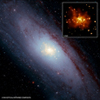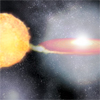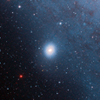Disclaimer: This material is being kept online for historical purposes. Though accurate at the time of publication, it is no longer being updated. The page may contain broken links or outdated information, and parts may not function in current web browsers. Visit chandra.si.edu for current information.
What Triggers Cosmology's Most Important Explosions?
by P. EdmondsFebruary 18, 2010 ::
The work by Gilfanov and Bogdan described in the recent Chandra Press release represents a major advance in understanding the origin of Type Ia supernovas. Here, in Q & A format, we give some of the backstory of this important discovery.
What is a Type Ia supernova?
A Type Ia supernova is thought to occur when a dense stellar remnant called a white dwarf somehow exceeds its weight limit and undergoes a thermonuclear explosion. Their peak brightness is generally greater than that of core-collapse supernovas, the class of supernova caused by the collapse of a young, massive star. Historical Type Ia supernovas such as Tycho's supernova were spectacular events, visible in the daytime by early astronomers.
http://chandra.harvard.edu/xray_sources/supernovas.html
What triggers these explosions?
The two main possibilities are the accretion scenario and the merger scenario, as explained in the press release. This work provides direct evidence against the accretion scenario in elliptical galaxies, implying that the merger scenario dominates in these galaxies. The accretion scenario is much more difficult to rule out in spiral galaxies because the presence of large amounts of cold gas and dust absorbs low energy X-rays expected from accreting white dwarfs and makes the interpretation of the data considerably more difficult.
Why is it important to understand how Type Ia supernovas are triggered?
These supernovas are used as "standard candles" to measure cosmic distances, because they usually have about the same intrinsic brightness, or luminosity. One major hope is that understanding how they are triggered will help them become even better standard candles in the future. If it was shown that different triggers occurred in different types of galaxies, for example, astronomers might be able to determine whether any sub-classes are less accurate standard candles than the others. One possibility is that a sub-class could have a broader range of brightness than another sub-class.
How can there be a range in brightness for Type Ia supernovas, if they are such good standard candles?
Type Ia supernovas are known to show a small range in luminosity. Supernovas with a slower decline from maximum light are brighter than the ones with a rapid decline. By correcting for this effect, the uncertainty in the luminosity of a Type Ia supernova can be reduced significantly. However, there is no guarantee that this standardization process will continue to work as astronomers strive for increasingly precise measurements of cosmic acceleration and dark energy (Howell et al., 2008).
What other evidence for Type Ia triggers has been found?
In early 2008 astronomers reported finding a Chandra X-ray source that coincided with the position of a Type Ia supernova called SN 2007on (Voss and Nelemans, 2008). If true, this would be the first ever detection of the progenitor of a Type Ia supernova, and would be an argument in favor of the accretion scenario trigger. However, further work has cast doubt upon the association of the X-ray source and the supernova. Information about the progenitors of other Type Ia supernovas has been found, with the detection of hydrogen pointing to the accretion scenario. However, this is indirect evidence.
The Gilfanov and Bogdan result represents a major advance because it goes well beyond individual systems to constrain the dominant progenitor type across entire galaxies.
What are some other constraints on Type Ia triggers?
A number of studies have looked at the estimated time between the birth of Type Ia progenitor stars and their final explosions, known as the delay time. So-called "prompt" explosions with delay times less than a few hundred million years have been observed, along with "delayed" explosions with delay times of billions of years, often found in elliptical galaxies. These results hint at two populations of Type Ias. Based on stellar evolution arguments, the accretion scenario trigger has more trouble producing delayed explosions than the merger scenario trigger does (Greggio, 2010), consistent with the result of Gilfanov and Bogdan.
Local examples of possible prompt Type Ia explosions have been studied with Chandra, including Kepler in our galaxy and DEM L238 and L249 in the nearby Large Magellanic Cloud, but it is unclear whether others, such as Tycho’s supernova, arose from delayed explosions.
Is there other evidence that Type Ias in elliptical galaxies are different from those in spiral galaxies?
For several years it has been noted that the Type Ia supernovas in elliptical galaxies are fainter than those in other galaxies. A recent study has extended this work by showing that the age of the host galaxy of a Type Ia supernova is correlated with the brightness of the supernova, with supernovas in younger galaxies - containing younger, more massive progenitors - being brighter (Howell et al., 2008). The authors explain this is hard to understand if most Type Ia supernovas explode when the primaries reach the Chandrasekhar mass. One possible explanation for this mystery is that the merger scenario is an important type of trigger in all types of galaxies not just ellipticals. Since more massive white dwarfs should be found in younger galaxies, they may be able to produce brighter explosions when they merge. However, more theoretical and observational work is needed to confirm this idea.
Does this evolution have implications for future work on dark energy?
The results mentioned above suggest that the properties of Type Ia supernovas evolve with time, with brighter explosions being found at earlier cosmic epochs. The standardization technique mentioned above corrects for this evolution, but a crucial question remains: how well can this correction work in the future? Uncorrected evolution would limit scientist's ability to probe dark energy with high precision, where variations with cosmic time are important. No tool is perfect, and only further work will reveal where the imperfections set in and how knowledge about the progenitors can help.
Luckily there are multiple probes of dark energy, including measurements of the cosmic microwave background, and use of galaxy clusters to make independent distance estimates and measure the effects of dark energy on the growth of clusters. Each of these techniques has their own strengths and weaknesses, but their combination with supernova work and other techniques provides an extremely powerful probe of dark energy.
Why else are Type Ia supernovas important?
They are thought to contribute about half the iron in the Universe (Ettori, 2005). Since we live in a spiral galaxy, the Gilfanov and Bogdan result does not directly tell us where the iron in our blood comes from, but it is a step in the right direction. These supernovas also play important roles in galaxy evolution because of the enormous amounts of energy they pump into their environment and they are very useful probes of binary and stellar evolution.
What implications are there for spotting nearby progenitors of Type Ias?
Judging by historical records, spectacular Type Ia supernovas within about ten thousand light years of the Earth occur about every five hundred years, at a rate only a few times lower than for nearby core-collapse supernovas. Progenitors for Type Ia supernovas in the Milky Way will be much harder to find if the merger scenario applies than if the accretion scenario applies, since two white dwarfs are thousands of times fainter than a Sun-like star, which in turn is much fainter than the progenitor of a core-collapse supernova. Depending on how well future astronomers do, mankind may be in for a surprise.
Disclaimer: This material is being kept online for historical purposes. Though accurate at the time of publication, it is no longer being updated. The page may contain broken links or outdated information, and parts may not function in current web browsers. Visit chandra.si.edu for current information.







